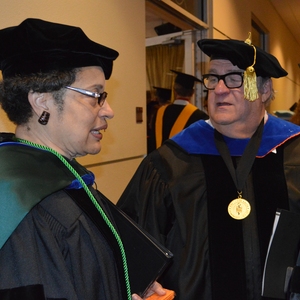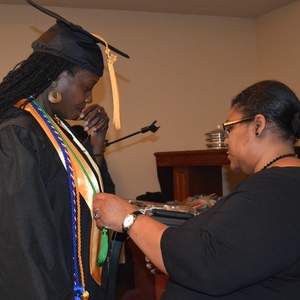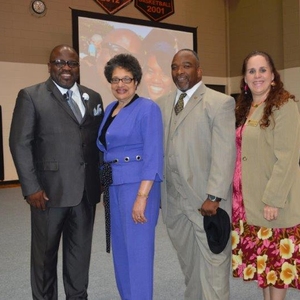Cedar Valley College a Center of Excellence of Sustainability in South Dallas, TX.
Dallas College
Project Overview
The Dallas County Community College District (DCCCD) consists of seven campuses enrolling 85,000 students from Dallas County and beyond. Cedar Valley College (CVC), one of the seven DCCCD campuses, serves approximately 8,000 students providing them with diverse educational opportunities including faculty and student training through the faculty-led Green Cord Program, Living Lab Initiatives, as well as monthly Sustainability Awareness events held throughout the year.
The Green Cord Program is the brainchild of CVC’s visionary Real Estate professor, Dr. Steve Brown. Dr. Brown is the creator of Q-TIPS, Quality Teaching in Practical Sustainability. Developed out of a need to incorporate sustainable practices in the classroom, Q-TIPS certification provides sustainability training to faculty members. Once certified, instructors are expected to weave sustainability practices and/or content into their courses across all disciplines, with support directed towards AASHE’s excellent DANS network. The main objective is to increase learning in undergraduate STEM courses, and to better prepare students for the ‘big questions’ of the 21st Century as they relate to real-world issues such as energy consumption, air and water quality, and climate change.
Q-TIPS certification has become a campus-wide initiative resulting in the conversion of a large percentage of courses to the ‘green’ status. Green Courses, taught by Q-TIPS certified instructors, are available across several disciplines including Real Estate, Marketing, Government, Human Development, Biology, Philosophy, English, Spanish, Energy Management, and Residential and Commercial Building Performance Technology. Green courses are designated on student transcripts and upon satisfactory completion of three green courses, in addition to all other graduation requirements, students are presented with a Green Cord, which can be worn during commencement. May 2014 marked the first group of students proudly wearing a Green Cord at graduation.
Today CVC’s Green Cord Program now features over 200 courses taught by Q-TIPS certified instructors. Additionally, many courses feature Living Lab Initiatives (1) including green economy angles, e.g. incorporating sustainability into class business plan projects, proposals to reroute campus traffic to minimize soil erosion in areas currently overly stressed by pedestrians, a solar powered moving ceramic mural that illustrates the photovoltaic process, as well as the student’s vision of what the triple bottom line is about. The Green Cord program has also experienced phenomenal growth in the past three years in terms of student participation. Eight students graduated with a Green Cord in 2014, increasing to 64 in 2015, and this spring 2016 semester jumping to almost 150 graduates receiving this distinction.
(1) The concept of Living Lab that is being used is the one developed by the SEED Center: Most colleges do not consider experiential learning opportunities as part of regular facilities improvement strategies, and sustainability-focused course projects are often employed only by faculty in environmental programs. It will require careful planning and collaboration—especially between facilities staff and faculty—for more colleges to develop these living laboratories in a way that maximizes all students’ learning experiences and yields benefits for the college’s bottom line. This guide highlights eight essential elements to building effective campus-wide living labs. It tackles some of the biggest challenges in these efforts, from breaking down internal institutional silos to addressing student safety to engaging industry. There is no single path to implementing living labs, but interviews with leaders of the most successful institutions revealed these common elements. Source: Retrieve February 27, 2015 from: http://www.twc.state.tx.us/news/press/2015/012315epress.pdf
Background
CVC serves predominantly African American and Hispanic populations, as such, research has proven disproportionate health impacts from emissions due to the use of coal, oil, and gas as well as climate change in lower income areas. As a result, CVC created Q-TIPS, the Living Lab Initiative, and the SCI to help address the quality of life within the community through a reduction in respiratory illness and asthma rates by bringing greater participation and using sustainable principles to promote sustainable development within the region.
Goals
- To utilize AASHE and community resources to create a robust sustainability curriculum through Q-TIPS, Living Labs, and related initiatives.
- To educate the next generation of leaders in sustainability by increasing the number of green cord program participants.
- To use project based teaching as a mechanism to ensure students are ‘job ready’ by using hands-on experiences to solve sustainability issues at CVC.
Implementation
- The green cord and Q-TIPS programs were implemented using AASHE and other premier institutions as resources.
- Q-TIPS was launched as a training program for faculty to integrate sustainable practices into their curriculum.
- Identified the courses and instructors best suited for the Q-TIPS program and invited them to participate.
- Tracked student participation in green courses and Living Lab Initiatives.
- Evaluated effectiveness and adjusted the program accordingly.
Timeline
- Research and Design: Following extensive research of similar programs and practices, Q-TIPS took approximately one year to implement from creation to faculty certification.
- The Q-TIPS program is publicized each semester in an effort to inform and increase the number of Q-TIPS certified instructors and green courses available on campus.
- Students are informed of the Green Cord program and the opportunities provided through the Living Lab Initiative and SCI upon enrollment.
- Quantification of how many students participated and measurement of student learning outcomes and results on students retention and completion.
Financing
No funding was needed to implement the Q-TIPS program, as resources were readily available on our campus and through AASHE. Real Estate professor, Dr. Steve Brown, donated his time and talent to develop the training program and initiate the creation of the Q-TIPS website where the certification process takes place.
Living Lab projects utilize existing resources such as clay from the ceramic lab, as well as photovoltaic arrays from the building performance program. Minimal maintenance, work hours, equipment, or resources are needed to support the projects and students.
Students pay no additional fees to participate in the SCI projects and gain marketable skills upon graduation leading to greater understanding of how to incorporate sustainable principles into daily practice.
Results
One of CVC’s most ambitious Living Lab initiatives, part of the Q-TIPS program, this year was an interdisciplinary collaboration between our Pottery faculty and our Solar Energy/Building Performance faculty. Over 100 students have participated in the process helping with the design and creation of an ambitious 8’ x 10’ ceramic sculpture that features several prominent CVC sustainability themes.
The sculpture depicts nurturing hands which cradle freshly grown produce representing the implementation of a campus butterfly and edible garden. Faculty, staff, and students are working together encircling a tree’s deep roots which represent the foundation we are working together to build while reaching out to our community teaching them not only how to live sustainably but how to prepare for and adapt to coming change. The bright sun bursts through the mural representing not only our mascot ‘sun’ but also our ongoing plans for a large solar array installment on campus that features many electrical connections, solar powered and motion activated pieces, as well as flowing water.
A mock-up has been created and installed in the art hallway, which will lead to a full-size sculpture that will be installed in the courtyard to beautify the open space and greet hundreds of campus-goers who walk by each day. This sculpture was envisioned to meet a need identified in a campus focus groups to have more prominent, permanent student-made artwork that communicates CVC’s central theme of sustainability. This project has many partners on campus and with the help of facilities, our community will be able to enjoy its message for years to come.
This academic year (2016-2017) the measurement of student learning outcomes and results on students retention and completion will begin.
Lessons Learned
There are many worthy academic projects to pursue through CVC’s SCI. Creating a space to discuss the needs of the students, faculty, staff, and community is paramount. The need to utilize solar energy and the creation of a community garden to improve the quality of life in this region were identified.
CVC’s President, Dr. Jennifer Wimbish working with the DCCCD Board of Directors, are striving to develop a RFP and moving forward with the vision of becoming a net zero campus with a diverse set of solar installments which are largely ground-mounted, but also containing carport and roof-top components. Through a partnership with the Dallas City Council, Honorable Erik Wilson has agreed to host a series of community feedback sessions throughout South Dallas to gather input from our neighbors to ensure their comments and concerns are addressed in any future development.
A need has been recognized to help alleviate southern Dallas County’s status as a food desert. The SCI is working with community partners, e.g. churches, local non-profits, and neighborhood groups to move forward with the implementation of a campus community garden to grow healthy local food. In doing so, CVC hopes to minimize travel emissions for transporting food and to connect students with knowledgeable sources on organic soil science that, when done right, can absorb carbon dioxide. Hands-on learning experiences like these have been shown to increase student retention, better prepare students for the workforce, as well as increasing the quality of life and food security for the community CVC serves.
CVC has been selected for the past two years (2015 and 2016) for Climate Leadership Award of the US Green Building Council/ Second Nature. The Environmental Protection Agency, Region 6 Administrator has recognized CVC as a community college that is helping transform individuals and communities in a sustainable way, increasing the quality of life in South Dallas, TX.



